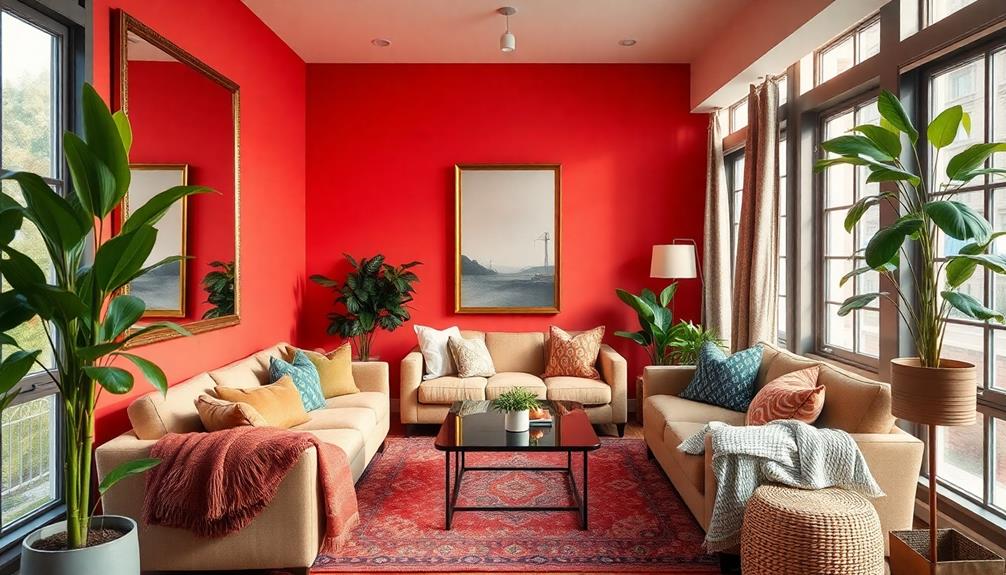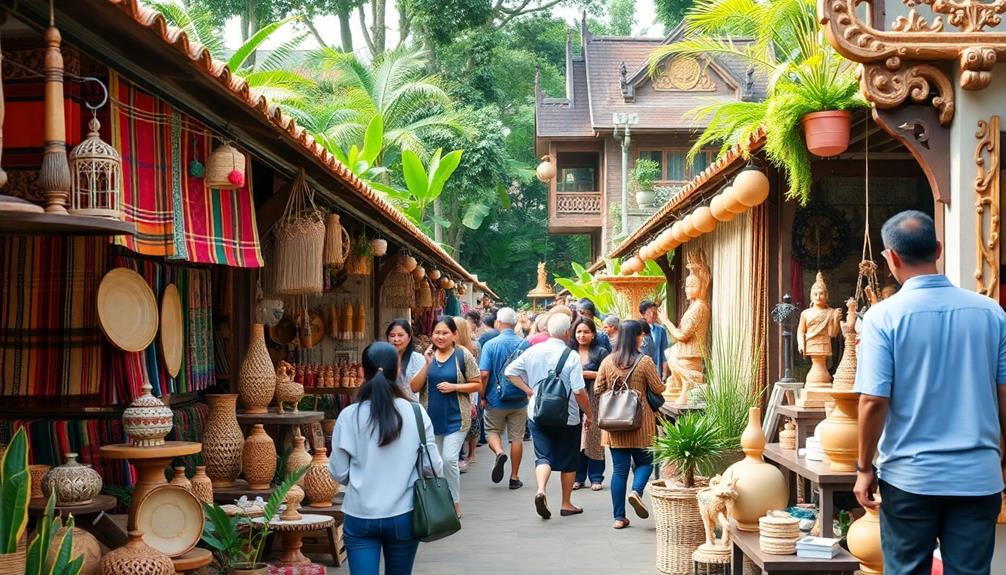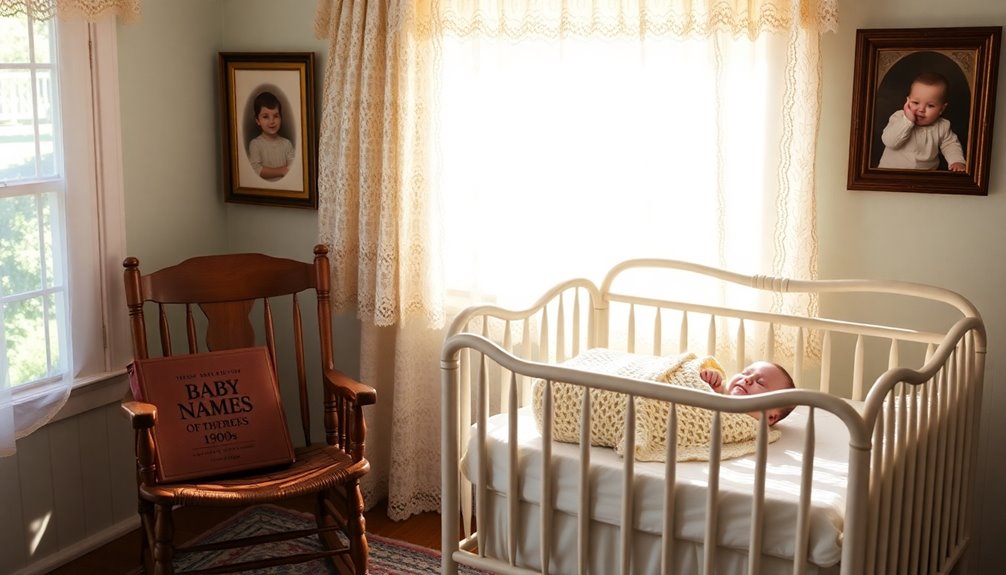Indonesian textiles, particularly batik, are a game-changer for your interiors. These stunning fabrics feature vibrant colors and intricate designs that instantly elevate any space. With various techniques like Batik Tulis, Batik Cap, and Batik Lukis, you can choose the perfect style to suit your decor. Incorporate batik through cushions, curtains, or wall art to create focal points that spark conversation. Not only do these textiles add beauty, but they also carry a rich cultural heritage, making them meaningful additions to your home. Keep exploring, and you'll discover even more ways to weave batik into your interior design. As a modern interiors trend, Indonesian batik has gained popularity for its unique and traditional aesthetic that brings depth and character to any space. Its timeless appeal and versatility allow it to seamlessly blend with contemporary decor, bringing a touch of history and culture into modern homes. Whether you opt for a subtle hint of batik or go all-out with statement pieces, this age-old art form is sure to make a striking impact in your interior design. For stunning Indonesian interior ideas, consider incorporating batik table runners, bedspreads, or even upholstering furniture with these exquisite fabrics. The combination of rich colors and intricate patterns will add a touch of exotic elegance to any room. Whether you’re drawn to traditional or modern decor, Indonesian textiles like batik are the perfect way to infuse your space with culture and artistry.
Key Takeaways
- Batik fabric offers vibrant colors and intricate patterns, making it a stunning choice for interior decor.
- Incorporate batik through cushions, throws, curtains, and wall art to elevate your space.
- Choose between various batik techniques like Batik Tulis for hand-drawn elegance or Batik Cap for uniform patterns.
- Modern designers blend traditional batik with contemporary styles, ensuring it fits diverse interior aesthetics.
- The resurgence of interest in sustainable fashion enhances the appeal of authentic batik textiles in homes.
Exploring Batik Fabric

When you explore batik fabric, you'll discover a rich tradition rooted in Indonesia's cultural heritage. Known for its vibrant colors and intricate designs, Indonesian batik showcases the skillful use of the wax-resist dyeing technique. This method involves applying hot wax to fabric, allowing artisans to create detailed traditional patterns that reflect various cultural traditions and narratives.
Additionally, incorporating affordable Indonesian decor masks alongside batik can further enrich the aesthetic of your space with cultural depth.
You'll find different types of batik, such as Batik Tulis (hand-drawn), Batik Cap (stamped), and Batik Lukis (painted). Each style reveals unique craftsmanship and design elements, making batik fabrics a fascinating addition to your collection.
Javanese batik, in particular, is celebrated for its complexity and storytelling through motifs that often signify social status and cultural significance.
Incorporating batik fabrics into your interior design can create a stunning visual impact. Whether you choose bold patterns for throw pillows or subtle designs for curtains, these textiles can enhance your space and bring a touch of Indonesian elegance.
Embrace the beauty of batik and let its rich heritage inspire your decor choices, transforming your home into a vibrant tapestry of cultural artistry.
Historical Roots of Batik

Batik's historical roots stretch back centuries, showcasing a textile technique that has evolved through various cultures and regions. This traditional Indonesian textile, particularly prevalent in Central Java, is derived from the Javanese word "bathikan," which means mark-making.
Over hundreds of years, Indonesian batik has developed distinct regional patterns, categorizing it into inland and coastal styles, each reflecting unique cultural influences. Additionally, batik motifs often share similarities with other forms of Indonesian art, such as the vibrant designs found in Indonesian decor masks, emphasizing the interconnectedness of these traditional crafts.
Through visual analysis, you can see how batik motifs often carry significant meanings. These designs not only signal social status but also honor history, making batik an essential part of Indonesia's material culture. The fabric serves as a symbol of national identity, representing the rich tapestry of Indonesian heritage.
However, despite its UNESCO heritage status, traditional batik faces challenges due to the rise of machine printing and cheaper alternatives. As these modern methods threaten the art form, it's important to appreciate and support the artisans who keep this centuries-old technique alive.
Types of Batik Techniques
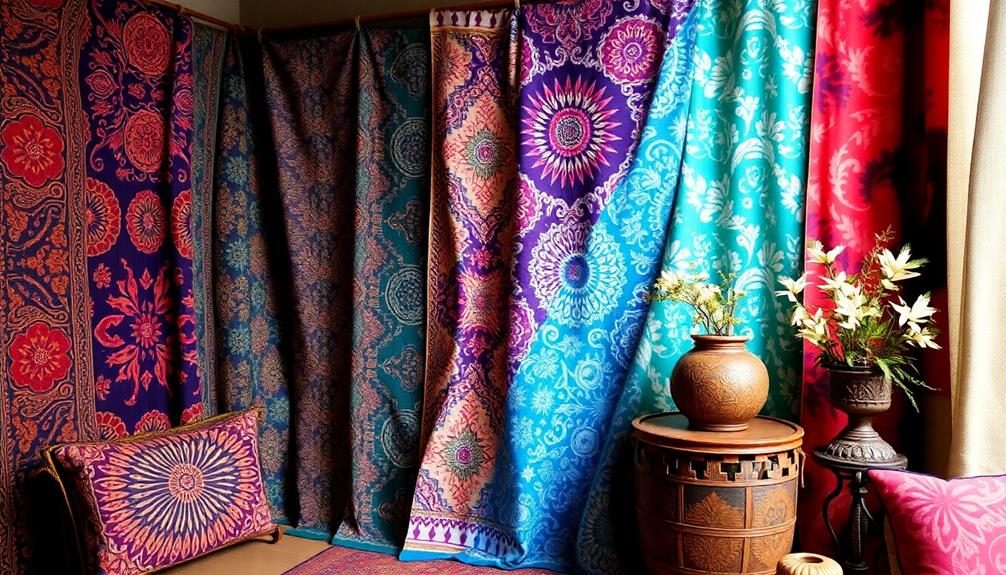
Indonesia's rich tapestry of textile techniques offers a fascinating glimpse into the world of batik, where each method reveals a unique story.
One of the most traditional and labor-intensive techniques is Batik Tulis, where artisans use a canting tool to hand-draw intricate designs. This meticulous dye process results in unique and expensive pieces that are highly valued, often showcased as part of Indonesian art decor that celebrates cultural heritage.
If you're looking for something more accessible, Batik Cap employs a stamped technique that allows for faster production of uniform patterns. This makes it a more affordable option while still showcasing beautiful Indonesian textiles.
For those who crave creativity, Batik Lukis presents a modern approach, where artists paint directly on undyed fabric, allowing for innovative imagery and personal expression.
You might also explore Batik Pesisir, which reflects the coastal influences of Indonesia with vibrant colors and diverse motifs that developed through trade.
Finally, Batik Belanda combines Western design elements with traditional Javanese patterns, a fascinating fusion that emerged during the Dutch colonial period.
Each technique not only showcases the skill involved but also tells a story of cultural exchange and identity.
Incorporating Batik in Interiors
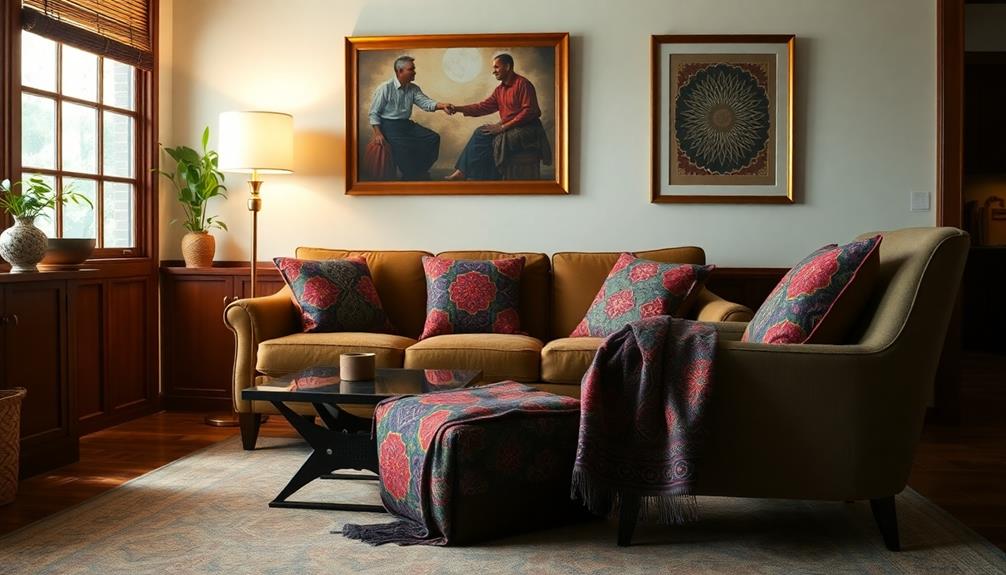
Integrating batik into your interiors can elevate your space with its vibrant colors and intricate patterns. This Indonesian art form, characterized by its handmade quality and wax-resist dyeing technique, brings a unique touch to your home decor.
Additionally, incorporating elements like Indonesian decor masks can further enhance the cultural richness of your space. You can easily incorporate batik through various applications like cushions, throws, curtains, and wall art, allowing for versatility in your interior design.
A batik collection adds a striking focal point, whether you prefer contemporary or traditional aesthetics. Each piece tells a story, showcasing cultural heritage, and can spark conversations with guests.
Brands like Sejauh Mata Memandang exemplify how modern interpretations of batik can seamlessly blend traditional techniques with contemporary design sensibilities.
Consider using bold batik prints in a throw or subtle patterns in cushions to create balance in your space. This approach not only enhances your interior design but also honors the historical richness and artistic expression inherent in batik textiles.
The Future of Batik Textiles

As global interest in sustainable fashion grows, batik textiles are finding new life through modern interpretations that respect traditional techniques. Designers are embracing eco-conscious trends by creatively integrating batik into contemporary collections, ensuring its cultural significance is preserved.
This revival highlights the beauty of handcrafted pieces, which tell unique stories and support local artisans. By collaborating with expert tropical design consultants, these designers are enhancing the use of batik in interior spaces, creating environments that celebrate both heritage and modern aesthetics.
Collaborative efforts, like those led by Lisa King, focus on preserving traditional batik craftsmanship. By incorporating upcycled fabrics, these initiatives not only promote sustainability but also educate the public about the labor-intensive process behind batik production.
This awareness is essential, as machine-produced alternatives threaten the authenticity of this art form. The demand for authentic batik has spurred a resurgence in artisanal production, with consumers increasingly seeking unique, handcrafted pieces that reflect their values.
Preservation initiatives are imperative to maintaining the traditional batik-making process, ensuring that future generations appreciate its rich heritage. As you explore the world of batik textiles, you'll discover a vibrant intersection of tradition and innovation, where the past informs the future, creating stunning interiors that embody both beauty and cultural depth.
Frequently Asked Questions
What Is the Indonesian Textile Technique?
Indonesian textile techniques include batik, with its wax-resist dyeing, and tapis, which uses handwoven cloth strips. You'll find various styles, each showcasing unique craftsmanship and cultural narratives, enriching the beauty of textile art.
What Is the Indonesian Method of Painting on Cloth?
You'll find Batik Lukis enchanting, where vibrant colors dance across undyed fabric. Artists wield brushes, layering dyes to create fluid, intricate designs that burst with personal expression and cultural motifs, transforming cloth into stunning art.
What Is the Famous Fabric Design of Indonesia?
The famous fabric design of Indonesia is Batik. You'll find its intricate patterns created through a traditional wax-resist dyeing technique. Each piece tells a unique story, reflecting the rich cultural heritage of the region.
What Are the Two Main Materials Used to Make Indonesian Batik?
Imagine vibrant colors dancing on fabric. The two main materials used to make Indonesian batik are cotton, known for its durability, and silk, which adds a luxurious sheen, transforming each piece into wearable art.
Conclusion
Incorporating Indonesian textiles like batik into your interiors can truly transform your space. Did you know that over 1,000 different batik patterns exist, each with its own unique story and meaning? By choosing batik, you're not just decorating; you're connecting with a rich cultural heritage. So why not embrace these stunning fabrics to add warmth and character to your home? With batik, you're not just styling your space; you're celebrating a timeless art form.



